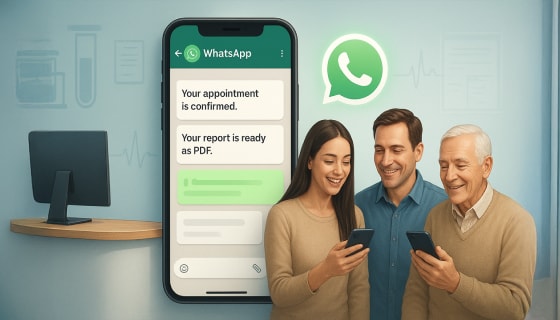Introduction
Healthcare dashboard tools are rapidly emerging as one of the most beneficial investments for a modern clinic. Even the smallest practice generates a wealth of data, from patient visits to campaign clicks. However, this information remains scattered across various tools, tabs, and inboxes without a dashboard. A well-structured dashboard consolidates everything into a clear view, empowering you to comprehend, make informed decisions, and act confidently.
In this blog, we’ll walk you through building a simple, insightful, and—most importantly—practical dashboard. No tech background is required, making it accessible to all healthcare professionals.
Why Healthcare Dashboards Matter
At its core, a healthcare dashboard is a visual tool that translates raw numbers into clear, easy-to-understand charts and summaries. It eliminates the need to dig through spreadsheets or switch platforms. Instead of relying on hunches or manual reports, healthcare professionals can get real-time insights at a glance—and use those insights to make informed, timely decisions. Let’s look at what makes dashboards valuable in everyday practice.
- Centralized Data Access: All your key metrics—financials, marketing results, operational data—live in one unified place.
- Real-Time Awareness: Track daily trends, such as new patient sign-ups, ad clicks, or budget spending, as they occur.
- Time-Saving & Stress-Reducing: Collecting and formatting data takes less time, allowing for more focus on care, growth, and strategic planning.
- Smarter Decision-Making: Whether you’re reviewing monthly ad performance or quarterly patient retention, dashboards spotlight what’s working—and what needs attention.
What to Track Monthly vs. Quarterly
When managing a healthcare practice, it’s crucial to understand that tracking everything all the time isn’t just exhausting—it’s unnecessary. Knowing what to measure regularly and what can wait for a broader review. Here’s a simple breakdown to help you get started.
Track These Monthly to Stay Agile
Monthly tracking enables you to identify trends, resolve issues promptly, and stay ahead of rapidly evolving campaigns.
| Metric | Why It Matters |
| New Patient Inquiries | See how many new leads your advertising and referral sources are generating. |
| Website Traffic | Understand how well your SEO, ads, and social media drive visitors. |
| Ad Campaign Performance | Review Google Ads and Meta Ads results—what’s working, what needs adjusting. |
| Top Performing Keywords & Channels | Know which platforms and terms are delivering ROI. |
| Conversion Rate (Leads to Appointments) | Track how many inquiries turn into booked appointments. |
| Social Media Engagement | Gauge what content resonates most and drives interaction. |
| Spend vs. Revenue from Paid Ads | Are your ads paying off? This ratio keeps your budget in check. |
Track These Quarterly (For Strategic Planning)
Quarterly tracking is ideal for spotting long-term shifts and adjusting your broader marketing strategy.
| Metric | Why It Matters |
| Patient Retention Rate | Understand how many patients are returning for follow-up care or additional treatment. |
| Overall Ad ROI | Evaluate the broader perspective of ad spend versus actual revenue generated. |
| Local SEO Performance | Review how your clinic ranks on Google for location-based searches. |
| Competitor Benchmarking | See how you stack up against others in your region or specialty. |
| Reputation & Review Trends | Are reviews improving? Any recurring issues that need attention? |
| Cost Per Lead (CPL) Over Time | Understand if your marketing efforts are becoming more or less efficient. |
Google Sheets Dashboard Template for Clinics
If you’re just starting, you don’t need expensive dashboard software. Google Sheets is a user-friendly tool that can do more than you might think. It’s free, cloud-based, and accessible to anyone on your team, making it perfect for solo doctors and multi-speciality clinics. With some structure, Google Sheets can become a powerful control panel for your clinic’s marketing and patient flow.
Here’s how you can set it up step by step:
- Start with a Monthly Summary Row: At the top of your sheet, list the most critical numbers—new patient leads, total ad spend, appointments booked, and estimated revenue. This will give you a quick snapshot every time you open the file.
- Track Your Metrics Over Time: Dedicate each row to a different month. In each column, record key metrics like website visitors, phone calls, leads from ads, social media engagement, and actual bookings. This helps you track growth or spot slowdowns early.
- Separate Data by Marketing Channel: Break down your results by channel—Google Ads, Meta Ads, SEO traffic, and referrals. Add columns to capture how each one is performing, so you can identify what’s bringing in results and what might need adjusting.
- Log Your Lead Sources Clearly: Maintain a section where you list each incoming lead and tag its source (e.g., “Google Ad Knee Campaign” or “Instagram Post Skin Clinic”). Over time, this reveals which sources yield actual patients.
- Include a Section for Notes or Observations: Sometimes numbers don’t tell the whole story. Add a column or side section for context, such as when you paused a campaign, had a holiday closure, or launched a new initiative. These insights help explain fluctuations in performance.
- Use Simple Formulas to Automate Totals: You don’t have to do the math manually. Use built-in functions in Google Sheets (like SUM(), AVERAGE(), or =B3/C3) to calculate totals, conversion rates, or growth percentages.
- Make It Visual with Conditional Formatting: Add green to metrics that are increasing and red to those that are decreasing. These subtle visual cues make your dashboard easier to scan at a glance, especially helpful during busy clinic hours.
As your clinic grows, you can connect your Sheet with tools like Zapier or Google Forms. This can be a great start, but having a simple CRM alongside your sheet can make life even easier if you’re juggling multiple campaigns or patients.
CRM Tools for Beginners
In today’s healthcare marketing, generating leads is only half the job. The real challenge lies in managing them and ensuring no opportunity slips through the cracks. A CRM (Customer Relationship Management) tool is your clinic’s digital assistant, keeping track of every patient inquiry, mapping out communication touchpoints, and helping your team follow up efficiently, without shuffling between spreadsheets, emails, or sticky notes.
You don’t need to be tech-savvy or invest heavily to start. Several platforms offer free plans that work beautifully for clinics just getting started.
HubSpot CRM (Free & Paid Plans)
HubSpot CRM is ideal for clinics seeking ease of use and marketing automation. Its key features include a visual sales pipeline, lead tracking, email templates, scheduling, and integration with Google Ads and Facebook Ads. It offers a free and paid plan with unlimited users starting at $20/month.
HubSpot is an excellent starting point if you’re looking for an intuitive platform with robust marketing features and a free plan that doesn’t feel restrictive.
Zoho CRM (Free & Paid Plans)
Zoho CRM is best for clinics that want more customization and operational control. Its key features include lead scoring, email campaigns, call logging, an AI-based sales assistant (Zia), and integrations with Google Workspace. The free plan is for up to 3 users, and paid plans start at $14/month. Healthcare giants such as Apollo Hospitals and MediBuddy utilize Zoho CRM for internal communication, data organization, and campaign tracking.
This tool is ideal for clinics that want to deeply customize their CRM to reflect workflows or handle multi-specialty data differently.
Freshsales by Freshworks (Free & Paid Plans)
Trusted by Tata 1mg, Cure.fit, and other digital health platforms, Freshsales is ideal for growing clinics that seek AI-driven insights and automation. Its key offerings include AI-based lead scoring, built-in calling, email tracking, and intelligent workflow automation. It offers a free and paid plan for small teams starting at $15/month.
It’s ideal for teams ready to move beyond basic CRM and leverage automation to streamline lead handling and patient engagement.
Beyond organization, a CRM gives your clinic the structure to grow sustainably. Here’s how that translates to real-world impact:
- You stay consistent with follow-ups with automated reminders and centralized contact records.
- You identify which campaigns work by tagging lead sources and tracking conversions over time.
- Your patient communication becomes more effective with personalized emails or calls tailored to past behavior or preferences.
- Your team works in sync since everyone shares the same visibility in patient interactions.
With everything organized in your CRM, it’s time to make your insights easier to digest—let’s talk about visual reporting.
Visual Reporting: Using Pie Charts, Trendlines, and Tables
Charts and graphs may seem like a small detail, but they make a significant impact. Instead of scanning rows of numbers, you can see trends, spot gaps, and make faster decisions—without needing a data analyst.
Even simple visuals like a pie chart or a line graph can answer critical questions quickly:
- Where are most of our leads coming from?
- Is ad spend translating into patient bookings?
- Which month had the most substantial return on investment?
Let’s explore three visual formats your clinic can easily use with tools like Google Sheets, Excel, or even within HubSpot and Zoho.
Pie Charts
Pie charts are ideal for displaying proportions and are particularly useful when analyzing lead sources or campaign performance. With one glance, you’ll know where to double down and which channels may need reevaluation.
Trendlines
Trendlines, or line graphs, help you understand how metrics change over time, typically measured in weeks or months. This makes it easier to measure campaign effectiveness and seasonal shifts. They’re ideal for tracking:
- Monthly new patient inquiries
- Cost per lead (CPL)
- Ad impressions vs. appointments booked
Tables
While visuals are great for high-level understanding, tables still play a key role, especially for tracking campaign-specific data. You can even highlight top rows with conditional formatting to make standout metrics pop. Use clean, colour-coded tables to:
- Compare budget vs. spend.
- Track conversions by channel.
- List the top-performing keywords or ads.
Conclusion
The truth is, most clinics aren’t short on data—they’re just short on time, tools, and the right system to make sense of it. But with just a bit of structure, a basic dashboard, and the proper reporting habits, you can stop guessing and start seeing. You’ll know what campaigns are working, which channels bring in patients, and where you might be overspending without results.
And you don’t need to figure it all out alone. At ZealousWeb, we help clinics build clear, patient-focused marketing systems that make growth less stressful and more measurable. Book a free 30-minute strategy call with our healthcare marketing team today.














